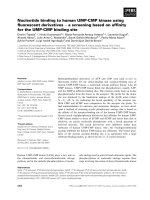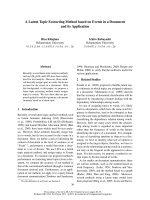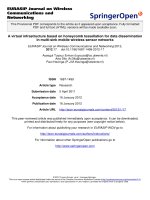The partitioning method based on hedge algebras for fuzzy time series forecasting
Bạn đang xem bản rút gọn của tài liệu. Xem và tải ngay bản đầy đủ của tài liệu tại đây (113.37 KB, 13 trang )
������������������������������������������������������������������������������������������������������������������������������������������������������������������������������������������������������������������������������������������������������������������������������������������������������������������������������������������������������������������������������������������������������������������������������������������������������������������������������������������������������������������������������������������������������������������������������������������������������������������������������������������������������������������������������������������������������������������������������������������������������������������������������������������������������������������������������������������������������������������������������������������������������������������������������������������������������������������������������������������������������������������������������������������������������������������������������������������������������������������������������������������������������������������������������������������������������������������������������������������������������������������������������������������������������������������������������������������������������������������������������������������������������������������������������������������������������������������������������������������������������������������������������������������������������������������������������������������������������������������������������������������������������������������������������������������������������������������������������������������������������������������������������������������������������������������������������������������������������������������������������������������������������������������������������������������������������������������������������������������������������������������������������������������������������������������������������������������������������������������������������������������������������������������������������������������������������������������������������������������������������������������������������������������������������������������������������������������������������������������������������������������������������������������������������������������������������������������������������������������������������������������������������������������������������������������������������������������������������������������������������������������������������������������������������������������������������������������������������������������������������������������������������������������������������������������������������������������������������������������������������������������������������������������������������������������������������������������������������������������������������������������������������������������������������������������������������������������������������������������������������������������������������������������������������������������������������������������������������������������������������������������������������������������������������������������������������������������������������������������������������������������������������������������������������������������������������������������������������������������������������������������������������������������������������������������������������������������������������������������������������������������������������������������������������������������������������������������������������������������������������������������������������������������������������������������������������������������������������������������������������������������������������������������������������������������������������������������������������������������������������������������������������������������������������������������������������������������������������������������������������������������������������������������������������������������������������������������������������������������������������������������������������������������������������������������������������������������������������������������������������������������������������������������������������������������������������������������������������������������������������������������������������������������������������������������������������������������������������������������������������������������������������������������������������������������������������������������������������������������������������������������������������������������������������������������������������������������������������������������������������������������������������������������������������������������������������������������������������������������������������������������������������������������������������������������������������������������������������������������������������������������������������������������������������������������������������������������������������������������������������������������������������������������������������������������������������������������������������������������������������������������������������������������������������������������������������������������������������������������������������������������������������������������������������������������������������������������������������������������������������������������������������������������������������������������������������������������������������������������������������������������������������������������������������������������������������������������������������������������������������������������������������������������������������������������������������������������������������������������������������������������������������������������������������������������������������������������������������������������������������������������������������������������������������������������������������������������������������������������������������������������������������������������������������������������������������������������������������������������������������������������������������������������������������������������������������������������������������������������������������������������������������������������������������������������������������������������������������������������������������������������������������������������������������������������������������������������������������������������������������������������������������������������������������������������������������������������������������������������������������������������������������������������������������������������������������������������������������������������������������������������������������������������������������������������������������������������������������������������������������������������������������������������������������������������������������������������������������������������������������������������������������������������������������������������������������������������������������������������������������������������������������������������������������������������������������������������������������������������������������������������������������������������������������������������������������������������������������������������������������������������������������������������������������������������������������������������������������������������������������������������������������������������������������������������������������������������������������������������������������������������������������������������������������������������������������������������������������������������������������������������������������������������������������������������������������������������������������������������������������������������������������������������������������������������������������������������������������������������������������������������������������������������������������������������������������������������������������������������������������������������������������������������������������������������������������������������������������������������������������������������������������������������������������������������������������������������������������������������������������������������������������������������������������������������������������������������������������������������������������������������������������������������������������������������������������������������������������������������������������������������������������������������������������������������������������������������������������������������������������������������������������������������������������������������������������������������������������������������������������������������������������������������������������������������������������������������������������������������������������������������������������������������������������������������������������������������������������������������������������������������������������������������������������������������������������������������������������������������������������������������������������������������������������������������������������������������������������������������������������������������������������������������������������������������������������������������������������������������������������������������������������������������������������������������������������������������������������������������������������������������������������������������������������������������������������������������������������������������������������������������������������������������������������������������������������������������������������������������������������������������������������������������������������������������������������������������������������������������������������������������������������������������������������������������������������������������������������������������������������������������������������������������������������������������������������������������������������������������������������������������������������������������������������������������������������������������������������������������������������������������������������������������������������������������������������������������������������������������������������������������������������������������������������������������������������������������������������������������������������������������������������������������������������������������������������������������������������������������������������������������������������������������������������������������������������������������������������������������������������������������������������������������������������������������������������������������������������������������������������������������������������������������������������������������������������������������������������������������������������������������������������������������������������������������������������������������������������������������������������������������������������������������������������������������������������������������������������������������������������������������������������������������������������������������������������������������������������������������������������������������������������������������������������������������������������������������������������������������������������������������������������������������������������������������������������������������������������������������������������������������������������������������������������������������������������������������������������������������������������������������������������������������������������������������������������������������������������������������������������������������������������������������������������������������������������������������������������������������������������������������������������������������������������������������������������������������������������������������������������������������������������������������������������������������������������������������������������������������������������������������������������������������������������������������������������������������������������������������������������������������������������������������������������������������������������������������������������������������������������������������������������������������������������������������������������������������������������������������������������������������������������������������������������������������������������������������������������������������������������������������������������������������������������������������������������������������������������������������������������������������������������������������������������������������������������������������������������������������������������������������������������������������������������������������������������������������������������������������������������������������������������������������������������������������������������������������������������������������������������������������������������������������������������������������������������������������������������������������������������������������������������������������������������������������������������������������������������������������������������������������������������������������������������������������������������������������������������������������������������������������������������������������������������������������������������������������������������������������������������������������������������������������������������������������������������������������������������������������������������������������������������������������������������������������������������������������������������������������������������������������������������������������������������������������������������������������������������������������������������������������������������������������������������������������������������������������������������������������������������������������������������������������������������������������������������������������������������������������������������������������������������������������������������������������������������������������������������������������������������������������������������������������������������������������������������������������������������������������������������������������������������������������������������������������������������������������������������������������������������������������������������������������������������������������������������������������������������������������������������������������������������������������������������������������������������������������������������������������������������������������������������������������������������������������������������������������������������������������������������������������������������������������������������������������������������������������������������������������������������������������������������������������������������������������������������������������������������������������������������������������������������������������������������������������������������������������������������������������������������������������������������������������������������������������������������������������������������������������������������������������������������������������������������������������������������������������������������������������������������������������������������������������������������������������������������������������������������������������������������������������������������������������������������������������������������������������������������������������������������������������������������������������������������������������������������������������������������������������������������������������������������������������������������������������������������������������������������������������������������������������������������������������������������������������������������������������������������������������������������������������������������������������������������������������������������������������������������������������������������������������������������������������������������������������������������������������������������������������������������������������������������������������������������������������������������������������������������������������������������������������������������������������������������������������������������������������������������������������������������������������������������������������������������������������������������������������������������������������������������������������������������������������������������������������������������������������������������������������������������������������������������������������������������������������������������������������������������������������������������������������������������������������������������������������������������������������������������������������������������������������������������������������������������������������������������������������������������������������������������������������������������������������������������������������������������������������������������������������������������������������������������������������������������������������������������������������������������������������������������������������������������������������������������������������������������������������������������������������������������������������������������������������������������������������������������������������������������������������������������������������������������������������������������������������������������������������������������������������������������������������������������������������������������������������������������������������������������������������������������������������������������������������������������������������������������������������������������������������������������������������������������������������������������������������������������������������������������������������������������������������������������������������������������������������������������������������������������������������������������������������������������������������������������������������������������������������������������������������������������������������������������������������������������������������������������������������������������������������������������������������������������������������������������������������������������������������������������������������������������������������������������������������������������������������������������������������������������������������������������������������������������������������������������������������������������������������������������������������������������������������������������������������������������������������������������������������������������������������������������������������������������������������������������������������������������������������������������������������������������������������������������������������������������������������������������������������������������������������������������������������������������������������������������������������������������������������������������������������������������������������������������������������������������������������������������������������������������������������������������������������������������������������������������������������������������������������������������������������������������������������������������������������������������������������������������������������������������������������������������������������������������������������������������������������������������������������������������������������������������������������������������������������������������������������������������������������������������������������������������������������������������������������������������������������������������������������������������������������������������������������������������������������������������������������������������������������������������������������������������������������������������������������������������������������������������������������������������������������������������������������������������������������������������������������������������������������������������������������������������������������������������������������������������������������������������������������������������������������������������������������������������������������������������������������������������������������������������������������������������������������������������������������������������������������������������������������������������������������������������������������������������������������������������������������������������������������������������������������������������������������������������������������������������������������������������������������������������������������������������������������������������������������������������������������������������������������������������������������������������������������������������������������������������������������������������������������������������������������������������������������������������������������������������������������������������������������������������������������������������������������������������������������������������������������������������������������������������������������������������������������������������������������������������������������������������������������������������������������������������������������������������������������������������������������������������������������������������������������������������������������������������������������������������������������������������������������������������������������������������������������������������������������������������������������������������������������������������������������������������������������������������������������������������������������������������������������������������������������������������������������������������������������������������������������������������������������������������������������������������������������������������������������������������������������������������������������������������������������������������������������������������������������������������������������������������������������������������������������������������������������������������������������������������������������������������������������������������������������������������������������������������������������������������������������������������������������������������������������������������������������������������������������������������������������������������������������������������������������������������������������������������������������������������������������������������������������������������������������������������������������������������������������������������������������������������������������������������������������������������������������������������������������������������������������������������������������������������������������������������������������������������������������������������������������������������������������������������������������������������������������������������������������������������������������������������������������������������������������������������������������������������������������������������������������������������������������������������������������������������������������������������������������������������������������������������������������������������������������������������������������������������������������������������������������������������������������������������������������������������������������������������������������������������������������������������������������������������������������������������������������������������������������������������������������������������������������������������������������������������������������������������������������������������������������������������������������������������������������������������������������������������������������������������������������������������������������������������������������������������������������������������������������������������������������������������������������������������������������������������������������������������������������������������������������������������������������������������������������������������������������������������������������������������������������������������������������������93.1
3709.8
04/12/1992
3651.4
3629.3
3740.9
3564.5
3693.1
3709.8
05/12/1992
3727.9
3629.3
3740.9
3564.5
3693.1
3709.8
07/12/1992
3755.8
3629.3
3740.9
3859.9
3693.1
3709.8
08/12/1992
3761
3629.3
3740.9
3859.9
3693.1
3709.8
09/12/1992
3776.6
3629.3
3740.9
3859.9
3693.1
3709.8
10/12/1992
3746.8
3629.3
3740.9
3859.9
3693.1
3709.8
11/12/1992
3734.3
3629.3
3740.9
3859.9
3693.1
3709.8
12/12/1992
3742.6
3629.3
3740.9
3859.9
3693.1
3709.8
14/12/1992
3696.8
3629.3
3740.9
3859.9
3693.1
3709.8
15/12/1992
3688.3
3629.3
3740.9
3564.5
3693.1
3709.8
16/12/1992
3674.9
3629.3
3740.9
3564.5
3693.1
3709.8
17/12/1992
3668.7
3629.3
3740.9
3564.5
3693.1
3709.8
18/12/1992
3658
3629.3
3740.9
3564.5
3693.1
3709.8
21/12/1992
3576.1
3629.3
3740.9
3564.5
3693.1
3709.8
22/12/1992
3578
3629.3
3477.1
3564.5
3519.4
3442.3
23/12/1992
3448.2
3629.3
3477.1
3564.5
3519.4
3442.3
24/12/1992
3456
3629.3
3477.1
3413.3
3519.4
3442.3
28/12/1992
3327.7
3629.3
3477.1
3413.3
3519.4
3442.3
29/12/1992
3377.1
3629.3
3368.1
3413.3
3519.4
3491.4
114.2
85.7
107.2
75.7
68.9
RMSE
580
The partitioning method based on Hedge Algebras for fuzzy time series forecasting
Also Applying FL for UNE [15] with 9 intervals, the forecasting result is presented in the
following Table 6:
Table 6. Comparing forecasting result on UNE.
Date
Actual data
Wang 2013
Chen
2013
Wang 2014
Lu 2015
The proposed
method
02/01/2013
7.7
7.39
7.60
7.62
7.58
7.51
03/01/2013
7.5
7.39
7.60
7.62
7.58
7.51
04/01/2013
7.5
7.39
7.60
7.62
7.58
7.51
05/01/2013
7.5
7.39
7.60
7.62
7.58
7.51
06/01/2013
7.5
7.39
7.60
7.62
7.58
7.51
07/01/2013
7.3
7.39
7.60
7.62
7.58
7.51
08/01/2013
7.2
7.39
7.12
7.13
7.07
6.99
09/01/2013
7.2
6.89
7.12
7.13
7.07
6.99
10/01/2013
7.2
6.89
7.12
7.13
7.07
6.99
11/01/2013
7.0
6.89
7.12
7.13
7.07
6.99
12/01/2013
6.7
6.89
7.12
7.13
7.07
6.99
0.20
0.18
0.19
0.17
0.16
RMSE
Comparing forecasting results of the proposed method with some forecasting result of
recently different methods on regular time series such as Alabama, TAIEX, UNE in Table 4,
Table 5 and Table 6 show that the proposed method gives better forecasting performance.
Besides, the proposed method only use arithmetic operations with simple way to calculate
forecasting result.
5. CONCLUSION
This paper presented a novel method of partitioning the universe of discourse, and used this
method in the method of using fuzzy time series to forecast time series, to improve forecasting
performance. The proposed method is formed by mean of the linguistic terms that are used to
qualitatively describe the historical values of fuzzy time series. Based on the linguistic terms, the
number of intervals, corresponding to the number of linguistic terms, and length of intervals,
corresponding to the fuzziness intervals, are determined.
581
Hoang Tung, Nguyen Dinh Thuan, Vu Minh Loc
From the experimental results on the regular time series, compare to forecasting result of
different methods, we can see that when using the proposed method to model fuzzy time series
gives better forecasting accuracy. The proposed method also shows that it is rather simple
because of using only arithmetic operations and simple way to calculate forecasting values.
REFERENCES
1.
Song Q., Chissom B.S - Fuzzy time series and its models, Fuzzy Sets and Systems 54 (3)
(1993a) 269–277.
2.
Song Q., Chissom B.S - Forecasting enrollments with fuzzy time series – Part I, Fuzzy
Sets and Systems 54 (1) (1993b) 1–9.
3.
Song Q., Chissom B. S. - Forecasting enrollments with fuzzy time series, Part II, Fuzzy
Sets and Systems 62 (1) (1994) 1–8.
4.
Shyi-Ming Chen - Forecasting enrollments based on fuzzy time series, Fuzzy Sets and
Systems 81 (1996) 311-319.
5.
Kunhuang Huarng - Efective lengths of intervals to improve forecasting in fuzzy time
series, Fuzzy Sets and Systems 123 (2001) 387–394
6.
Kunhuang Huarng - Heuristic models of fuzzy time series for forecasting, Fuzzy Sets and
Systems 123 (2001) 369–386.
7.
Shyi-Ming Chen, Nien-Yi Chung - Forecasting enrollments using high-order fuzzy time
series and genetic algorithms, International journal of intelligent systems 21 (2006) 485–
501.
8.
Tahseen Ahmed Jilani, Syed Muhammad Aqil Burney, and Cemal Ardil - Fuzzy metric
approach for fuzzy time series forecasting based on frequency density based partitioning,
International Journal of Computer, Information, Systems and Control Engineering 4
(7)(2010) 39-44.
9.
Shyi-Ming Chen, Chia-Ching Hsu - A new method to forecast enrollments using fuzzy
time Series, International Journal of Applied Science and Engineering 2 (3) (2004) 234244.
10. Kunhuang Huarng, Tiffany Hui-Kuang Yu - Ratio-based lengths of intervals to improve
fuzzy time series forecasting, IEEE transactions on systems, man, and cybernetics—part
b: cybernetics 36 (2) (2006) 328-340.
11. Shyi-Ming Chen, Pei-Yuan Kao - TAIEX forecasting based on fuzzy time series, particle
swarm optimization techniques and support vector machines, Information Sciences 247
(2013) 62–71.
12. Lizhu Wang, Xiaodong Liu, Witold Pedrycz - Effective intervals determined by
information granules to improve forecasting in fuzzy time series. Expert Systems with
Applications 40 (2013) 5673–5679.
13. Lizhu Wang, Xiaodong Liu, Witold Pedrycz, Yongyun Shao - Determination of temporal
information granules to improve forecasting in fuzzy time series, Expert Systems with
Applications 41 (2014) 3134–3142.
14. Eren Bas, Vedide Rezan Uslu, Ufuk Yolcu, Erol Egrioglu - A modified genetic algorithm
for forecasting fuzzy time series, Applied Intelligence 41 (2014) 453-463.
582
The partitioning method based on Hedge Algebras for fuzzy time series forecasting
15. Wei Lu, XueyanChen, WitoldPedrycz, XiaodongLiua, JianhuaYang - Using interval
information granules to improve forecasting in fuzzy time series, International Journal of
Approximate Reasoning 57 (2015) 1–18.
16. Nguyen Cat Ho, Nguyen Van Long - Fuzziness measure on complete hedge algebras and
quantifying semantics of terms in linear hedge algebras, Fuzzy Sets and Systems 158
(2007) 452 – 471.
17. Cat Ho Nguyen, Witold Pedrycz, Thang Long Duong, Thai Son Tran - A genetic design
of linguistic terms for fuzzy rule based classifiers, International Journal of Approximate
Reasoning 54 (2013) 1-21.
583









